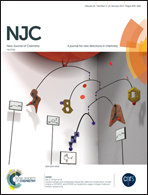Observation of enhanced photocurrent response in M–CuInS2 (M = Au, Ag) heteronanostructures: phase selective synthesis and application†
Abstract
We report controlled synthesis of CuInS2 in wurtzite and zinc blende phases by solution based thermal decomposition of dual precursors [In(acda)3] (acda = 2-aminocyclopentene-1-dithiocarboxylic acid) and [Cu(PPh3)2(acda)] (PPh3 = triphenylphosphine) in the presence of appropriate surface-active agents. Furthermore, the preparation of M–CuInS2 (M = Au and Ag) heteronanostructures on both the phases has been achieved successfully by hot injection of respective gold and silver precursor solutions into the reaction mixture. The characterization of both pure and hybrid nanostructures was carried out by X-ray diffraction (XRD), UV-vis spectroscopy, energy dispersive X-ray (EDX) study and transmission electron microscopy (TEM). A detailed photovoltaic study has been performed with both pure materials and the twin structures and their photocurrent and photoresponse behavior have been compared. The study reveals that upon loading Au and Ag, the material exhibits high photocurrent efficiency compared to pure CuInS2. An appreciable increase in the light to dark current density ratio confirms that these materials can be used in the fabrication of promising photovoltaic devices.



 Please wait while we load your content...
Please wait while we load your content...